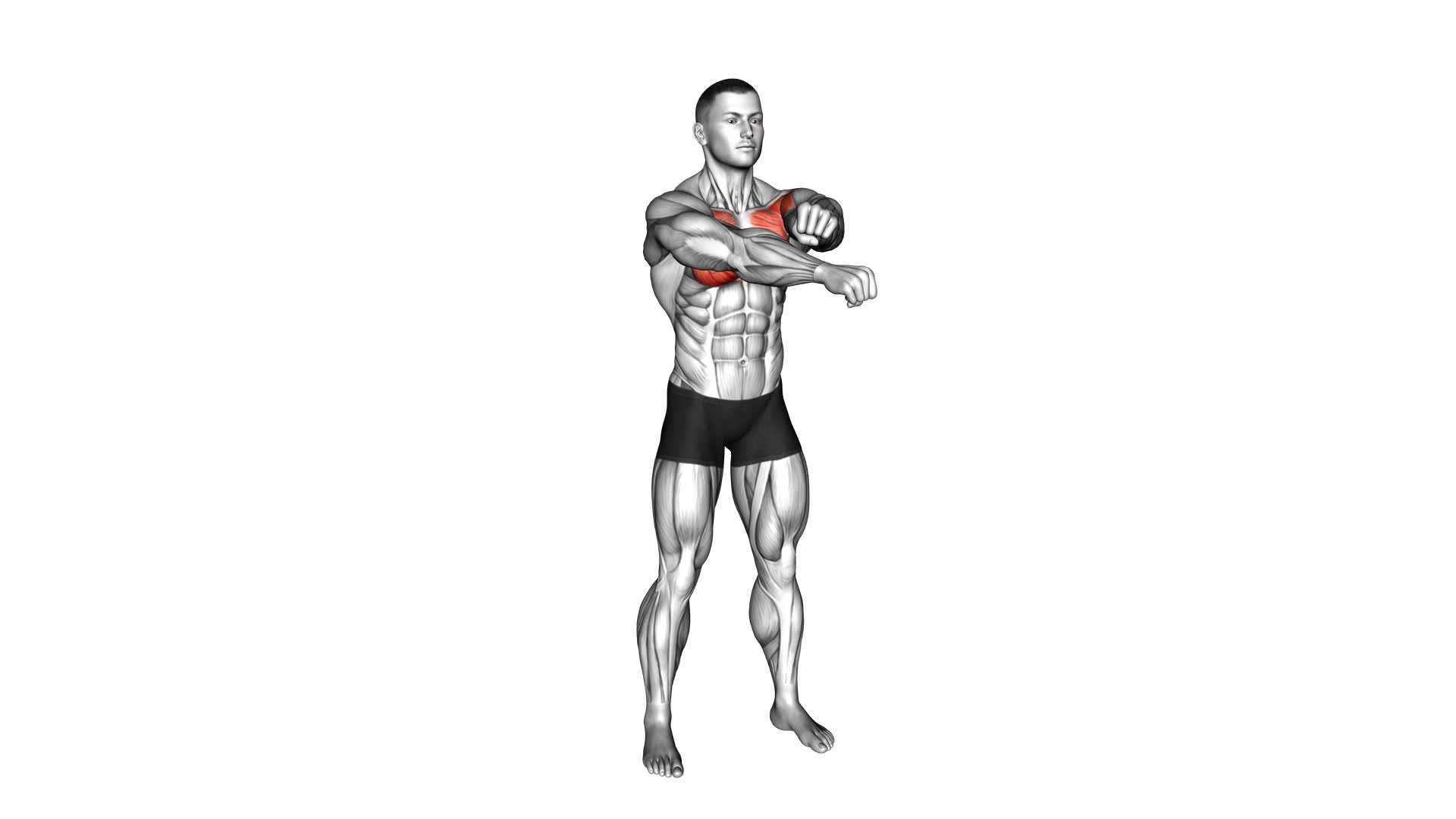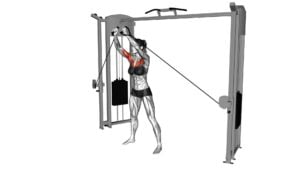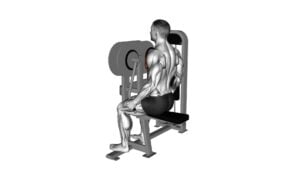Pulsing Chest Crossovers (male) – Video Exercise Guide & Tips

Are you looking to strengthen your chest muscles and improve your upper body strength? Look no further than pulsing chest crossovers!
Watch This Exercise Video
In this video exercise guide, you'll learn the proper form and technique for this effective exercise. With easy-to-follow instructions and helpful tips, you'll be able to perform pulsing chest crossovers with confidence.
So grab your mat and get ready to feel the burn in your chest as you take your workout to the next level. Let's get started!
Key Takeaways
- Pulsing Chest Crossovers (male) activate and strengthen the chest muscles.
- They provide cardiovascular benefits and boost cardiovascular endurance.
- These exercises target and strengthen the pectoral muscles, improving upper body strength and posture.
- Pulsing Chest Crossovers also enhance stability, balance, and engage the core muscles throughout the exercise.
Benefits of Pulsing Chest Crossovers
Experience the incredible benefits of Pulsing Chest Crossovers as you engage in this powerful exercise. This exercise not only helps to activate your chest muscles but also provides significant cardiovascular benefits. By performing Pulsing Chest Crossovers, you can effectively target and strengthen your pectoral muscles, helping to improve upper body strength and posture.
During this exercise, the repetitive motion of crossing your arms in front of your chest engages the pectoral muscles, causing them to contract and work harder. This muscle activation not only helps to build and tone your chest muscles but also contributes to increased overall strength and stability.
In addition to the muscle activation, Pulsing Chest Crossovers also provide cardiovascular benefits. The continuous movement of crossing your arms and pulsing engages your heart and lungs, increasing your heart rate and promoting cardiovascular health. This exercise can help to improve your endurance, stamina, and overall cardiovascular fitness.
To ensure you experience the full benefits of Pulsing Chest Crossovers, it's essential to maintain proper form and technique. By following the correct form, you can maximize the muscle activation and cardiovascular benefits while reducing the risk of injury. Let's now explore the proper form and technique for performing Pulsing Chest Crossovers.
Proper Form and Technique
To perform Pulsing Chest Crossovers with proper form and technique, you should ensure that your body is properly aligned and your movements are controlled. Common misconceptions about this exercise include the idea that you need to use heavy weights or swing your body to achieve results. However, the key to maximizing the effectiveness of Pulsing Chest Crossovers lies in maintaining the correct form.
Begin by standing with your feet shoulder-width apart and your knees slightly bent. Hold a pair of dumbbells in each hand, with your palms facing forward. Start the exercise by bringing your arms out to your sides, parallel to the ground. Next, cross your arms in front of your chest, while keeping your elbows slightly bent. Make sure to squeeze your chest muscles as you bring your arms together.
It's important to keep your core engaged and your back straight throughout the exercise. Avoid rounding your shoulders or arching your back. Remember to breathe naturally and focus on the quality of your movements rather than the quantity.
Variations and alternatives to Pulsing Chest Crossovers can include performing the exercise on an incline bench or using resistance bands instead of dumbbells. These variations can provide additional challenges and target different muscle groups. However, it's crucial to maintain proper form and technique regardless of the variation chosen.
Equipment and Setup
You can set up the equipment for Pulsing Chest Crossovers by using dumbbells and ensuring your feet are shoulder-width apart with your knees slightly bent. Here are some important safety precautions and recommended weights to keep in mind:
Safety Precautions:
- Always warm up before starting the exercise to prevent injury.
- Keep your core engaged and maintain proper form throughout the exercise.
- Start with lighter weights and gradually increase as you build strength and confidence.
- If you have any pre-existing medical conditions or injuries, consult a professional before attempting this exercise.
Recommended Weights:
- Beginners should start with weights around 5 to 10 pounds.
- Intermediate level individuals can use weights ranging from 10 to 20 pounds.
- Advanced individuals can challenge themselves with weights above 20 pounds.
- The weight you choose should be challenging enough to complete the exercise with proper form, but not too heavy that it compromises your technique.
Modifications and Progressions
Modify and progress your Pulsing Chest Crossovers by increasing the weight and intensity of the exercise. To make modifications, you can start by using heavier dumbbells or resistance bands during the exercise. This will challenge your muscles even more and help you build strength. Additionally, you can increase the number of repetitions or sets that you perform. This will further push your muscles and enhance the effectiveness of the exercise.
To take your Pulsing Chest Crossovers to the next level and try advanced variations, you can incorporate plyometric movements. For example, you can perform explosive chest crossovers by quickly crossing your arms over your chest while jumping in the air. This won't only engage your chest muscles but also increase your power and explosiveness.
Another advanced variation is the single-arm chest crossover. Instead of crossing both arms, you'll only cross one arm over your chest at a time. This will require more stability and coordination, intensifying the exercise.
Remember to always maintain proper form and technique while modifying or progressing your Pulsing Chest Crossovers. Listen to your body and gradually increase the weight and intensity to avoid any injuries. By incorporating modifications and advanced variations, you can continue challenging yourself and achieving new fitness goals.
Common Mistakes to Avoid
One common mistake to avoid when performing Pulsing Chest Crossovers is improper alignment of the arms and chest. This can greatly affect the effectiveness of the exercise and increase the risk of injury. To ensure proper technique and maximize your results, here are some important tips to keep in mind:
- Maintain a straight back throughout the exercise. Avoid rounding your shoulders or hunching forward, as this can strain your neck and upper back.
- Keep your chest lifted and open. Imagine pulling your shoulder blades together and down towards your spine to engage the muscles of your chest.
- Keep your elbows slightly bent and in line with your shoulders. Avoid locking your elbows or allowing them to collapse inward, as this can put unnecessary stress on your joints.
- Focus on the movement of your chest rather than your arms. Your arms should act as an extension of your chest, allowing for a controlled and fluid motion.
Frequently Asked Questions
How Many Reps and Sets Should I Do When Performing Pulsing Chest Crossovers?
When performing pulsing chest crossovers, it's important to consider your fitness goals. The optimal frequency for this exercise can vary depending on what you're aiming for.
If your goal is muscle endurance, aim for higher reps (around 12-15) and multiple sets (3-4).
If you're looking to build strength and muscle size, lower reps (around 6-8) and fewer sets (2-3) will be more effective.
Adjusting the rep and set ranges can help you tailor this exercise to your specific fitness goals.
Can Pulsing Chest Crossovers Help Improve My Overall Upper Body Strength?
Pulsing chest crossovers can definitely help improve your overall upper body strength. These exercises target the chest muscles, as well as the shoulders and triceps. By incorporating pulsing chest crossovers into your workout routine, you can enhance your upper body strength and build lean muscle.
Additionally, if you're looking for alternatives to pulsing chest crossovers, you can try exercises like push-ups, dumbbell chest presses, or cable chest flies to work the same muscle groups.
Will Pulsing Chest Crossovers Help Me Build a Bigger Chest?
Pulsing chest crossovers, along with other chest crossover variations, can be effective in helping you build a bigger chest. These exercises specifically target your chest muscles and can contribute to overall chest development.
However, it's important to note that these exercises should be complemented with a well-rounded workout routine that includes other alternative exercises for chest development, such as bench press, push-ups, and dumbbell flyes. Incorporating a variety of exercises will provide a more comprehensive approach to building a bigger chest.
Can I Perform Pulsing Chest Crossovers if I Have a History of Shoulder Injuries?
If you have a history of shoulder injuries, it's important to take precautions when performing pulsing chest crossovers. Make sure to consult with a healthcare professional or a qualified trainer before attempting this exercise.
They can provide you with modifications or alternative exercises that are better suited for your condition. Remember, your safety and well-being should always come first, so don't hesitate to ask for guidance.
Are There Any Specific Breathing Techniques I Should Follow While Doing Pulsing Chest Crossovers?
When doing pulsing chest crossovers, it's important to focus on your breathing technique. Take deep breaths in and out as you perform the exercise to ensure that you're getting enough oxygen to your muscles.
You can also modify the exercise if you're a beginner by starting with lighter weights or performing the movement without weights at all.
Remember to listen to your body and adjust the intensity as needed.
Conclusion
In conclusion, pulsing chest crossovers are a beneficial exercise for targeting the chest muscles. By using proper form and technique, individuals can maximize the effectiveness of this exercise.
It's important to have the appropriate equipment and setup, and modifications and progressions can be made to suit different fitness levels. Avoiding common mistakes will ensure a safe and efficient workout.
Incorporating pulsing chest crossovers into your exercise routine can help improve chest strength and overall upper body development.

Author
Years ago, the spark of my life’s passion ignited in my mind the moment I stepped into the local gym for the first time. The inaugural bead of perspiration, the initial endeavor, the very first surge of endorphins, and a sense of pride that washed over me post-workout marked the beginning of my deep-seated interest in strength sports, fitness, and sports nutrition. This very curiosity blossomed rapidly into a profound fascination, propelling me to earn a Master’s degree in Physical Education from the Academy of Physical Education in Krakow, followed by a Sports Manager diploma from the Jagiellonian University. My journey of growth led me to gain more specialized qualifications, such as being a certified personal trainer with a focus on sports dietetics, a lifeguard, and an instructor for wellness and corrective gymnastics. Theoretical knowledge paired seamlessly with practical experience, reinforcing my belief that the transformation of individuals under my guidance was also a reflection of my personal growth. This belief holds true even today. Each day, I strive to push the boundaries and explore new realms. These realms gently elevate me to greater heights. The unique combination of passion for my field and the continuous quest for growth fuels my drive to break new ground.







